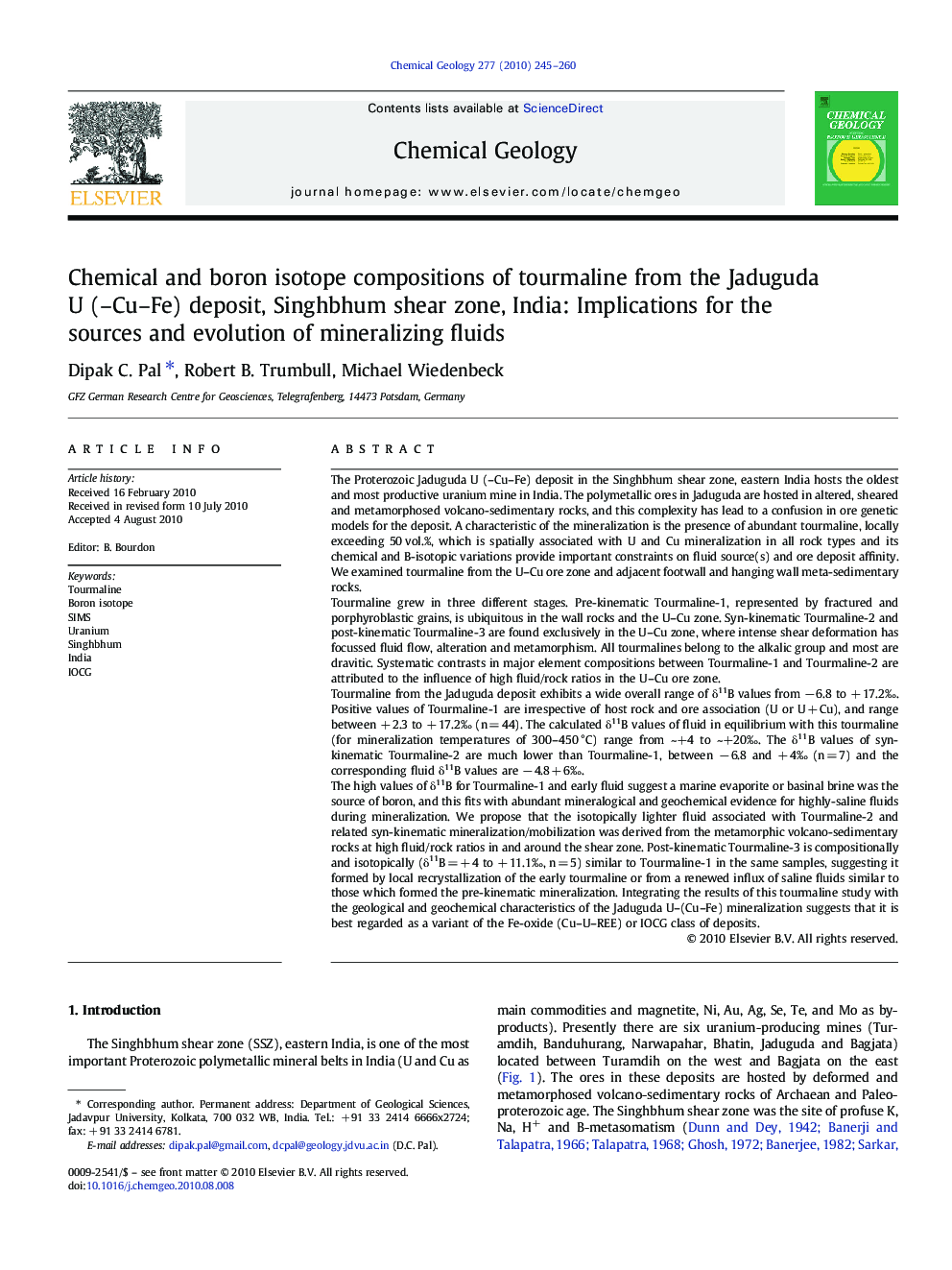| کد مقاله | کد نشریه | سال انتشار | مقاله انگلیسی | نسخه تمام متن |
|---|---|---|---|---|
| 4699906 | 1637681 | 2010 | 16 صفحه PDF | دانلود رایگان |

The Proterozoic Jaduguda U (–Cu–Fe) deposit in the Singhbhum shear zone, eastern India hosts the oldest and most productive uranium mine in India. The polymetallic ores in Jaduguda are hosted in altered, sheared and metamorphosed volcano-sedimentary rocks, and this complexity has lead to a confusion in ore genetic models for the deposit. A characteristic of the mineralization is the presence of abundant tourmaline, locally exceeding 50 vol.%, which is spatially associated with U and Cu mineralization in all rock types and its chemical and B-isotopic variations provide important constraints on fluid source(s) and ore deposit affinity. We examined tourmaline from the U–Cu ore zone and adjacent footwall and hanging wall meta-sedimentary rocks.Tourmaline grew in three different stages. Pre-kinematic Tourmaline-1, represented by fractured and porphyroblastic grains, is ubiquitous in the wall rocks and the U–Cu zone. Syn-kinematic Tourmaline-2 and post-kinematic Tourmaline-3 are found exclusively in the U–Cu zone, where intense shear deformation has focussed fluid flow, alteration and metamorphism. All tourmalines belong to the alkalic group and most are dravitic. Systematic contrasts in major element compositions between Tourmaline-1 and Tourmaline-2 are attributed to the influence of high fluid/rock ratios in the U–Cu ore zone.Tourmaline from the Jaduguda deposit exhibits a wide overall range of δ11B values from − 6.8 to + 17.2‰. Positive values of Tourmaline-1 are irrespective of host rock and ore association (U or U + Cu), and range between + 2.3 to + 17.2‰ (n = 44). The calculated δ11B values of fluid in equilibrium with this tourmaline (for mineralization temperatures of 300–450 °C) range from ~+4 to ~+20‰. The δ11B values of syn-kinematic Tourmaline-2 are much lower than Tourmaline-1, between − 6.8 and + 4‰ (n = 7) and the corresponding fluid δ11B values are − 4.8 + 6‰.The high values of δ11B for Tourmaline-1 and early fluid suggest a marine evaporite or basinal brine was the source of boron, and this fits with abundant mineralogical and geochemical evidence for highly-saline fluids during mineralization. We propose that the isotopically lighter fluid associated with Tourmaline-2 and related syn-kinematic mineralization/mobilization was derived from the metamorphic volcano-sedimentary rocks at high fluid/rock ratios in and around the shear zone. Post-kinematic Tourmaline-3 is compositionally and isotopically (δ11B = + 4 to + 11.1‰, n = 5) similar to Tourmaline-1 in the same samples, suggesting it formed by local recrystallization of the early tourmaline or from a renewed influx of saline fluids similar to those which formed the pre-kinematic mineralization. Integrating the results of this tourmaline study with the geological and geochemical characteristics of the Jaduguda U–(Cu–Fe) mineralization suggests that it is best regarded as a variant of the Fe-oxide (Cu–U–REE) or IOCG class of deposits.
Research highlights
► Tourmaline in the Jaduguda uranium deposit, Singhbhum, India grew in multiple stages.
► Besides the host rocks, hydrothermal fluid had pronounced control on tourmaline composition.
► δ11B values of pre-deformation tourmaline can best be ascribed to marine evaporite/basinal brine.
► Boron for syn-deformation tourmaline was likely derived from volcano-sedimentary rocks.
► This study and other lines of evidences support an IOCG model for the Jaduguda deposit.
Journal: Chemical Geology - Volume 277, Issues 3–4, 20 October 2010, Pages 245–260